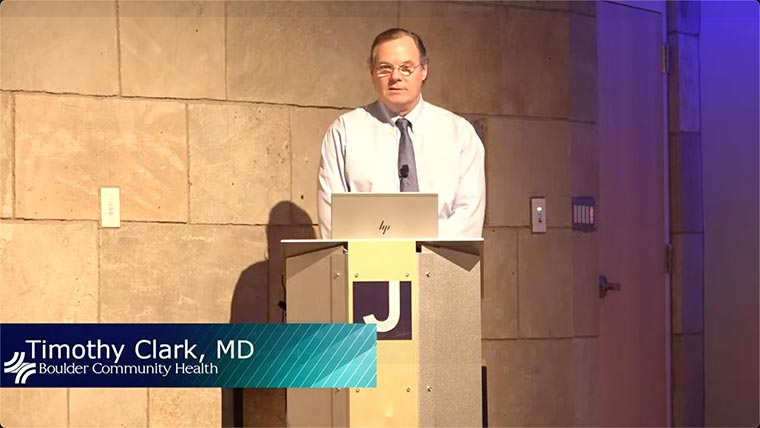Timothy Clark, MD, on Lung Cancer: Screening & Risk Factors

Lung cancer is the leading cause of cancer deaths in American men and women. Although cigarettes smokers are most at risk, anyone can get lung cancer. In fact, the lifetime risk for all adults — smokers and nonsmokers — is 1 in 15 for men and 1 in 17 for women.
“When detected early, it’s more likely to be successfully treated. Unfortunately, one-in-four cases of lung cancer are diagnosed after the disease has spread. This is the reason it is so deadly,” noted board-certified pulmonologist Timothy Clark, MD, FCCP of Boulder Valley Pulmonology during a recent online health lecture.
__________________________________________________________________________________________
VIDEO: Watch Dr. Clark's lecture on "Protecting Yourself From Lung Cancer: No. 1 Cancer Killer."
__________________________________________________________________________________________
Cigarette Smoking: The No. 1 Risk Factor That You Can Control
About 90% of lung cancer deaths are thought to result from smoking. “People who smoke cigarettes are 15 to 30 times more likely to develop lung cancer or die from it than those who don’t smoke,” said Dr. Clark.
The longer you smoke and the more packs a day you smoke, the greater your risk. If you quit smoking completely, you can reduce your risk of developing lung cancer. He explained, “While you’ll never get back to the risk factor of a nonsmoker, after five years your risk will be reduced and after 15 years, you’ll reduce your risk by 80 to 90%.”
Screening for Smokers
If you are a heavy smoker, especially if you started at a young age or have smoked for a long time, you should have annual lung cancer screenings. Boulder Community Health (BCH) offers comprehensive lung cancer screening as an American College of Radiology designated lung cancer screening site.
Dr. Clark stressed, “Annual lung cancer screenings are the best option available for detecting early lung cancer and for saving lives.”
The U.S. Preventative Services Task Force (USPSTF) recommends screenings:
- Using a low-dose computerized tomography (CT) scan to screen adults aged 55 to 80 who
- Have a history of heavy smoking (a 30 pack-year history of smoking, which means one pack a day for 30 years, two packs a day for 15 years) and
- Smoke now or have quit within the past 15 years
To learn more about screening for lung cancer, read Is Lung Cancer Screening Right For Me?
Other Risk Factors You Can Control
Several other controllable risk factors can make you more likely to develop lung cancer.
- Secondhand smoke. The Surgeon General provides significant documentation that secondhand smoke definitively is a risk factor for lung cancer. Dr. Clark noted that a person who’s exposed to secondhand smoke is 1.3 times more likely to develop lung cancer than a person who’s not exposed. “For children,” he explained, “if there are two smokers in the household, the risk for these children of developing lung cancer doubles.”
- Cigar smoking and pipe smoking. Cigar smoking and pipe smoking are less likely to cause lung cancer compared cigarette smoking, but are still significant risk factors.
- Exposure to radon. This is one of the leading causes of lung cancer for nonsmokers. “Fifty percent of homes in Colorado have higher readings than are acceptable,” said Dr. Clark. If you’re a smoker and exposed to radon, your risk is much higher than for nonsmokers. You can test and mitigate for radon.
- Exposure to asbestos. People who aren’t wearing masks and work directly with asbestos where fibers are being aerosolized are at risk for developing asbestos lung cancer. “If you’re exposed to a building with asbestos but no destruction is occurring, there’s very little risk of developing lung cancer,” said Dr. Clark. Mesothelioma is a cancer of the lung lining associated with asbestosis. Dr. Clark noted, “It’s a rare form of cancer with a long latency period. Twenty to 30 years can elapse between exposure and the time it’s detected, and exposure would need to have been significant, up to 15 to 20 years.”
- Recreational drug use. “We don’t have as much data on this as we do for cigarettes. It’s possible, though it’s unclear, if smoking marijuana or cocaine is linked to lung cancer. With opium there is an increased risk when smoked or ingested and it is dose dependent,” Dr. Clark stated.
- Indoor cooking and heating. Dr. Clark explained, “Ventilation helps significantly, however for those who use bituminous (black) coal for cooking and/or heating, we generally see a 20% increase in lung cancer.” The connection between lung cancer and the use of wood for cooking and heating remains unclear.
Risk Factors You Cannot Change
- Air pollution. Air pollution’s contribution to lung cancer is very small compared to smoking.
- Radiation therapy. Individuals undergoing radiation to the chest for other cancers are at higher risk. “But the risk of developing lung cancer from radiation therapy for other diseases is low as your exposure is closely monitored,” Dr. Clark stated.
- Lung disease. According to Dr. Clark, certain lung disease such as Chronic Obstructive Pulmonary Disease (COPD), Idiopathic Pulmonary Fibrosis (IPF), Tuberculous, alpha-1 (S or Z allele), and asbestosis put you at higher risk for lung cancer.
- Genetics. If you have a first degree relative who has had lung cancer, you certainly may be at risk.
Lung Cancer Symptoms
Symptoms of lung cancer can vary from person to person, but commonly include:
- Chronic coughing
- Cough that produces blood
- Shortness of breath
- Chest pain
- Unintentional weight loss
- Poor appetite
View PowerPoint slides from Dr. Clark’s lecture, “Protecting Yourself from Lung Cancer: No. 1 Cancer Killer.”
Call 303-415-5399 for more information or to schedule an appointment with Timothy Clark, MD.